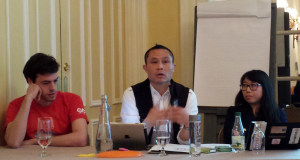
This year, I had the great privilege to attend the Digital Media and Learning Conference in Boston, Massachusetts, where I had organized a panel called “Creating Youth Builders – Promoting a New Game Design Ecosystem to Engage Hard-to-Reach Youth in Learning.” The heavy hitters on the panel included Jennifer Groff, a graduate researcher at the MIT Media Lab and the VP of Learning for the Learning Games Network, Ricarose Roque, a PhD student with the Scratch Team at the MIT Media Lab, Leshell Hatley, Founder and Executive Director of Uplift, Inc., Brianna Igbinosun, a high school student who won the Best Scratch High School Game in the 2013 National STEM Video Game Challenge, and Patrice King, one of the Co-Founders of Hidden Level Games. During the 90-minute session, panelists discussed their existing methods of engaging hard-to-reach youth, including workshops that focus on inter-generational learning and students of color.
Here are some insights from the session on how to really engage these students productively:
- Organizers should set the students up to speak to each other. Given that all the participants come from various backgrounds and may differ in experience, students might find it intimidating to try to get ideas across without fearing judgment.
- Encourage instructors to overcome their doubts about whether or not they could teach or relate to the kids. As one panelist pointed out, “They are just kids!”
- Barriers to entry must be low and must be marketed as such to catch participants’ attention.
- Parent engagement is huge – leverage them to encourage consistent attendance, have them participate in the workshops themselves, and keep them informed.
- Incorporate research and set aside time for observation to improve the program over time. Panelists spoke about how their curricula was not only based on educational methodologies and research on using game design to learn but also made sure to document lessons learned throughout the program.
- Utilize instructors that are slightly older or who were formerly in the program. Though it might be difficult to sustain them over time, they will provide valuable advice for improving the program, will have a strong familiarity with the material and teaching style, and can serve as peer mentors.
One recurring issue that was brought up during the session was hardware. The panelists collectively agreed that if a program doesn’t have access to the proper hardware, game design methods can still be taught with paper and pencil. Check out the panelists’ programs to download materials:
- www.learninggamesnetwork.org
- http://www.upliftdc.org/classes.html
- http://day.scratch.mit.edu/resources
- http://betathegame.gamepedia.com/

The other session I was a part of was “Developing STEM Literacy through Game Play and Game Design.” During the conversation, organizer Barry Joseph, Associate Director for Digital Learning at the American Museum of Natural History, engaged all of us in a discussion around game-based learning and its potential in teaching STEM content and practices like scientific reasoning and design skills. Afterwards, each of the panelists presented the games that we were working on with our respective institutions: I got to speak about Elemental, a video game for children ages 7-11 that aims to improve “number sense,” or a person’s innate ability for number estimation.
Throughout the session, attendees were eager to understand how kids feel about learning in games and to what extent do we as game developers show them this value. In response, there was a heated discussion about how learning and fun should go hand in hand rather than in completely separate buckets. Though some may think that all fun and play will not bode well for learning, when being challenged and overcoming problems successfully, players will find that intrinsically fun itself. The audience was also eager to hear more about designing games around specific curricula, games as a tool for assessment, low-hanging fruit for educational games, and research-based games. You can hear more about our responses in the video below.
These issues were also a running theme throughout the whole conference. One panel, “Doing ‘Good’ Game Design” with Jesse Schell of Schell Games, Richard Tate of Hope Labs, Jessica Berlinski of If You Can, and Tanner Higgin of Common Sense Media, discussed several research-based games that targeted more high-hanging fruit – shaping attitudes and behaviors and providing kids with skills for productive and healthy living. At one point, Jesse Schell spoke about how socio-emotional learning games are difficult to create because above-the-neck mechanics like thinking and speaking are much harder to design for compared to below-the-neck mechanics like running and jumping. Jessica Berlinski provided details on their process and how they aligned the game with Illinois’s Socio-Emotional State Standards, the only State Standards for that content area. One takeaway that resonated with me was Jesse’s comment that the art of all entertainment is to get someone to care about something that’s not initially important to them. Empathy is essentially embedded in games and part of the groundwork for engaging and fun games.
Of course, this is just a tidbit of all the bubbling conversations that happened at the conference. For more details and recordings of many of the sessions, go to to DML 2014 website: dml2014.dmlhub.net. You can also read more about our session Developing STEM Literacy through Gameplay and Game Design on the following blog post: http://www.mooshme.org/2014/03/dml2014-wrap-up-developing-stem-literacy-through-gameplay-and-game-design/

